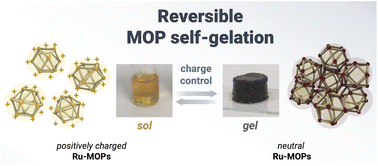Porous supramolecular gels produced by reversible self-gelation of ruthenium-based metal–organic polyhedra†
Abstract
Supramolecular gels based on metal–organic polyhedra (MOPs) represent a versatile platform to access processable soft materials with controlled porosity. Herein, we report a self-gelation approach that allows the reversible assembly of a novel Ru-based MOP in the form of colloidal gels. The presence of cationic mixed-valence [Ru2(COO)4]+ paddlewheel units allows for modification of the MOP charge via acid/base treatment, and therefore, its solubility. This feature enables control over supramolecular interactions, making it possible to reversibly force MOP aggregation to form nanoparticles, which further assemble to form a colloidal gel network. The gelation process was thoroughly investigated by time-resolved ζ-potential, pH, and dynamic light scattering measurements. This strategy leads to the evolution of hierarchically porous aerogel from individual MOP molecules without using any additional component. Furthermore, we demonstrate that the simplicity of this method can be exploited for the obtention of MOP-based gels through a one-pot synthetic approach starting from MOP precursors.



 Please wait while we load your content...
Please wait while we load your content...